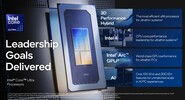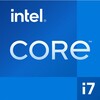Intel Core Ultra 7 165H vs Intel Core i7-1370P
Intel Core Ultra 7 165H
► remove from comparison
The Intel Core Ultra 7 165H is a high-end laptop processor of the Meteor Lake series. This 1st Gen Core Ultra chip has come to replace 13th generation Core chips; it has 16 cores (6 + 8 + 2) and 22 threads at its disposal. The 16 cores are comprised of 6 HT-enabled Performance cores running at up to 5.0 GHz and 10 Efficient cores (8 main cores plus 2 extra ones found in the Low Power Island) running at up to 3.8 GHz. Two of the 10 E-cores are located in the Low Power Island.
The 8-core Arc GPU, just out of the oven, serves as the integrated graphics adapter - this runs at up to 2.30 GHz - and there is a bevy of other brand-new technologies on offer as well, including the integrated AI Boost NPU with two Gen 3 engines for hardware AI workload acceleration.
Architecture and Features
With Meteor Lake, Intel intends to deliver higher CPU performance, higher GPU performance and at the same time, longer battery life than what Raptor Lake chips were capable of. The company also wants a large piece of the AI cake and is working with Microsoft and other partners to make that happen. As a result, Windows Defender is now AI-enabled, meaning it can use the Intel NPU to take some of the load off the main CPU cores. We also get this new Intel Device Discovery technology that is designed to give us a better hardware-based remote laptop management than ever before; and, to make things even better, Intel now offers a dedicated Arc Pro graphics driver for workstations.
This generation of Intel Core processors features Redwood architecture P-cores and Crestmont architecture E-cores. Both come with architectural improvements over Raptor Cove and Gracemont respectively for slightly higher performance-per-clock figures; the interesting thing is that of the 10 E-cores, two are actually a separate cluster located on what Intel calls a "Low Power Island". Essentially, the latter is an SoC within an SoC that can stay active while most other parts of the chip are temporarily switched off to save power. The low-power E-cores run at up to 2.5 GHz. Intel hopes this approach will let it deliver unprecedentedly low power consumption figures when under low load, boosting battery life of laptops and tablets powered by Meteor Lake.
To build Meteor Lake processors, Intel uses the Foveros technology (stacking several chips on top of each other). This is a cost-cutting measure more than anything else, as manufacturing several small dies on several different processes is so much cheaper than making a huge single die and hoping that there are no defects in it that will require disabling some parts of it.
Elsewhere, the Core Ultra 7 165H comes with 24 MB of L3 cache and a very healthy number of PCIe 5 and PCIe 4 lanes for NVMe SSD speeds up to 15.7 GB/s. vPro Enterprise and business-centric features such as the Remote Platform Erase are onboard as well. It supports RAM running at up to 7467 MHz (DDR5-5600, LPDDR5-7467, LPDDR5x-7467, to be specific - which is about as good as what 8040 series Ryzen chips have). Naturally, the chip also features built-in Thunderbolt 4 support and Intel CNVi Wi-Fi support; fascinatingly enough, Intel chose to keep native SATA III support that AMD had removed from its Ryzen processors quite a while ago.
The 165H is compatible with 64-bit Windows 10, 64-bit Windows 11 and with many Linux distros.
Performance
If one chooses to trust the official Intel performance data, then the 165H is about as fast as the Ryzen 9 6900HX (Zen 3 Plus, 8 cores, 16 threads, up to 4.9 GHz), as far as multi-thread benchmark scores are concerned. This isn't a ground-breaking result but let's just wait for our in-house testing results instead of jumping to conclusions.
Either way, real-world performance of the chip may vary significantly depending on how high the CPU power limits are and how competent the cooling solution of the system is.
Graphics
The 8-core Arc GPU running at up to 2.30 GHz is slated to be a proper alternative to the mighty Radeon 780M. The thing is almost as fast as the GTX 1650 (Laptop) and the RTX 2050 (Laptop) to represent some seriously solid performance gains over aging Xe-series integrated GPUs. If one chooses to take Intel's word for it, that is.
A proper DX12 Ultimate graphics adapter, the Arc is no stranger to ray tracing and other modern technologies including AI frame generation (XeSS). It will let you connect up to four SUHD 4320p monitors and it will both HW-encode and HW-encode the most widely used video codecs including AVC, HEVC and AV1 in a fast and efficient manner.
Your mileage may vary depending on how high the CPU power limits are, how competent the cooling solution of your system is, how fast the RAM of your system is. The latter is really important; Intel stresses that for the Arc to deliver the best results possible, multi-channel RAM configuration is a must.
Power consumption
This mighty Core Ultra 7 series processor has a Base power consumption of 28 W, while its Turbo power consumption is not supposed to exceed 115 W. A powerful cooling solution is a must for any system powered by this chip.
The 165H is comprised of five small chips ("tiles") that are connected using Intel's Foveros technology. The tile containing main CPU cores is produced on the fairly modern 7 nm Intel process marketed as Intel 4 while most other tiles (the iGPU, the I/O die, ...) are built with TSMC's N5 and N6 processes. The base tile is built with the old Intel 22FFL process.
Intel Core i7-1370P
► remove from comparison
The Intel Core i7-1370P is the flagship Alder Lake-P CPU, which is to say, an expensive 28 W part meant for use in ultra-light (yet actively cooled) laptops. This CPU will probably be announced in early 2023 and it has 6 performance cores (P-cores, Golden Cove architecture) mated to 8 efficient cores (E-cores, Gracemont architecture) according to a leak on Geekbench. The P-cores are Hyper-Threading-enabled for whopping 20 threads when combined with the E-cores. The clock speeds can reach up to 5.2 GHz for the performance cluster (1.9 GHz base speed) and 1.4 GHz to 3.9 GHz for the efficiency cluster. The CPU is quite similar to the older Core i7-1280P but probably offers higher clock speeds.
Full vPro feature set is supported by this Core i7 ("Enterprise" tier, allowing for remote device management).
Architecture
The i7 is a continuation of Intel's efforts to use the ARM-developed big.LITTLE technology for its own benefit. A single "little" Alder Lake core is supposed to be just as fast as a Skylake core (as found in the venerable Core i7-6700HQ among other options) which is six years old at this point. All of a Core i7-1280P's CPU cores enjoy access to 24 MB of L3 cache. The integrated memory controller supports up to 64 GB of LPDDR5-5200, DDR5-4800, LPDDR4x-4267 or DDR4-3200 RAM. Just like the other 12th Gen Intel Core processors, Core i7-1280P comes with Thread Director which is a new functionality designed to help Windows 11 decide which cores to use for what workload for best performance and efficiency possible. Hardware acceleration of AI algorithms is supported via GNA 3.0 and DL Boost (via AVX2). PCI-Express 5.0 support has not found its way into Alder Lake P processors, so users will have to be content with PCI-Express 4.0 for the time being. The CPU still only supports PCIe 4.0 x8 for a GPU and two PCIe 4.0 x4 for SSDs.
Please note this is not a user-replaceable CPU. It gets soldered permanently on to the motherboard (BGA1744 socket interface).
Performance
Multi-thread performance is most comparable to AMD Ryzen 9 5900HS, Ryzen 9 PRO 6950HS, Intel Core i9-11980HK. Which is impressive but comes with a catch; long-term performance sustainability will be rather poor unless the Power Limits are very high and the cooling solution is a truly capable one.
Graphics
The built-in graphics adapter in the form of the 96 EU Iris Xe running at up to 1.5 GHz has seen no change from what was built into the 11th Gen Tiger Lake-UP3 processors, like a i7-1165G7, which is hardly a downside as this iGPU is loaded with modern features such as AV1 video decoding capability and SUHD 4320p monitor support.
Power Consumption
The i7's base power consumption (also known as the default TDP value or PL1) is 28 W, with 64 W being its maximum Intel-recommended Turbo power consumption (also known as the PL2). The "Minimum Assured" power consumption is fairly high at 20 watts. All in all, an active cooling solution is nearly a must.
Core i7-1370P is built with Intel's third-gen 10 nm process marketed as Intel 7.
| Model | Intel Core Ultra 7 165H | Intel Core i7-1370P | ||||||||||||||||||||||||||||||||||||
| Codename | Meteor Lake-H | Raptor Lake-P | ||||||||||||||||||||||||||||||||||||
| Series | Intel Meteor Lake-H | Intel Raptor Lake-P | ||||||||||||||||||||||||||||||||||||
| Series: Raptor Lake-P Raptor Lake-P |
|
| ||||||||||||||||||||||||||||||||||||
| Clock | 3800 - 5000 MHz | 1400 - 5200 MHz | ||||||||||||||||||||||||||||||||||||
| L3 Cache | 24 MB | 24 MB | ||||||||||||||||||||||||||||||||||||
| Cores / Threads | 16 / 22 6 x 5.0 GHz Intel Redwood Cove P-Core 8 x 3.8 GHz Intel Crestmont E-Core 2 x 2.5 GHz Intel Crestmont E-Core | 14 / 20 6 x 5.2 GHz Intel Golden Cove P-Core 8 x 3.9 GHz Intel Gracemont E-Core | ||||||||||||||||||||||||||||||||||||
| TDP | 28 Watt | 28 Watt | ||||||||||||||||||||||||||||||||||||
| Technology | 7 nm | 10 nm | ||||||||||||||||||||||||||||||||||||
| max. Temp. | 110 °C | 100 °C | ||||||||||||||||||||||||||||||||||||
| Socket | BGA2049 | FCBGA1744 | ||||||||||||||||||||||||||||||||||||
| Features | DDR5-5600/LPDDR5-7467/LPDDR5x-7467 RAM, PCIe 5, Thr. Director, DL Boost, AI Boost, vPro Enterprise, RPE, MMX, SSE, SSE2, SSE3, SSSE3, SSE4.1, SSE4.2, AES, AVX, AVX2, AVX-VNNI, FMA3, SHA | Thread Director | ||||||||||||||||||||||||||||||||||||
| iGPU | Intel Arc 8-Core iGPU ( - 2300 MHz) | Intel Iris Xe Graphics G7 96EUs ( - 1500 MHz) | ||||||||||||||||||||||||||||||||||||
| Architecture | x86 | x86 | ||||||||||||||||||||||||||||||||||||
| Announced | ||||||||||||||||||||||||||||||||||||||
| Manufacturer | ark.intel.com | ark.intel.com | ||||||||||||||||||||||||||||||||||||
| L1 Cache | 1.2 MB | |||||||||||||||||||||||||||||||||||||
| L2 Cache | 11.5 MB |
Benchmarks
Average Benchmarks Intel Core Ultra 7 165H → 100% n=26
Average Benchmarks Intel Core i7-1370P → 94% n=26
* Smaller numbers mean a higher performance
1 This benchmark is not used for the average calculation













